|
Click any typewriter
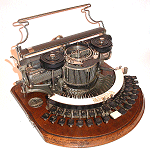
Hammond 2 -- 1895
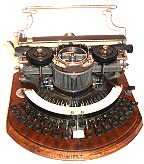
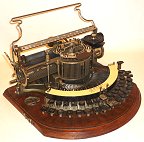
Hammond 2 - 1902
Braille attachment
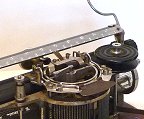
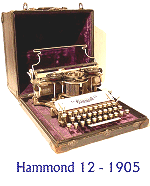
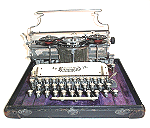

Hammond Multiplex
Folding - 1921
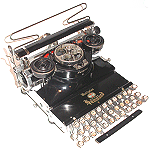
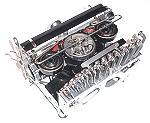
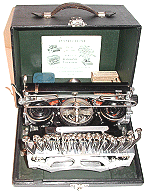
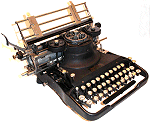
Varityper 'Handy' --
c1950
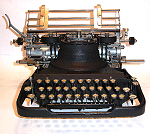
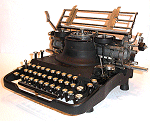


|
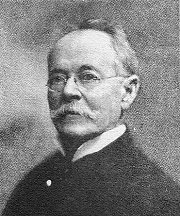 The
first real competitor to the Remington desk typewriter was the machine
designed by an American journalist, James Bartlett Hammond (1839-1913).
Hammond
had been a shorthand court reporter who had also covered the Civil War, and
is said to have conceived the idea for a printing machine after seeing his
dispatches garbled by telegraph operators. During the 1870s, without any
engineering training, he worked on a typing machine that used a single
printing element, a typewheel or shuttle, instead of a set of type bars. The
first real competitor to the Remington desk typewriter was the machine
designed by an American journalist, James Bartlett Hammond (1839-1913).
Hammond
had been a shorthand court reporter who had also covered the Civil War, and
is said to have conceived the idea for a printing machine after seeing his
dispatches garbled by telegraph operators. During the 1870s, without any
engineering training, he worked on a typing machine that used a single
printing element, a typewheel or shuttle, instead of a set of type bars.
It is probable that Hammond drew his inspiration
from the machine called the Pterotype, invented by John Pratt, an American
living in England, and based on a typewheel. A description of Pratt’s
machine was published in Scientific American in 1867 and this article
inspired many typewriter pioneers including Christopher Sholes and Lucien
Crandall. Hammond was an astute businessman and offered Pratt a cash sum and
royalty to stay out of the typewriter business, an offer that Pratt
accepted. This effectively gave Hammond control of Pratt's patent for the
typewheel. Hammond’s first commercial machine appeared by 1884.
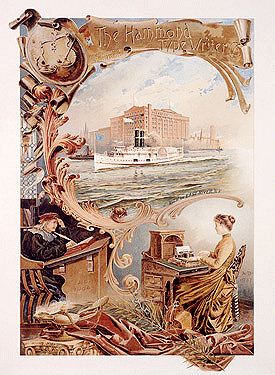 The
Hammond machine was significantly smaller and lighter than the Remington
simply because its typewheel design required far fewer parts, so the
potential for portability seemed to be there from the outset. The machine
was also provided with a wooden cover, just like portable machines of a
couple of decades later. However, at a thumping 22 pounds, the early Hammond
was a long way from being portable. (See the Hammond model 2 of 1895
illustrated at left.) The
Hammond machine was significantly smaller and lighter than the Remington
simply because its typewheel design required far fewer parts, so the
potential for portability seemed to be there from the outset. The machine
was also provided with a wooden cover, just like portable machines of a
couple of decades later. However, at a thumping 22 pounds, the early Hammond
was a long way from being portable. (See the Hammond model 2 of 1895
illustrated at left.)
Hammond was also concerned about helping visually
handicapped typists and introduced a factory-modified version of the Hammond
2 with a Braille attachment over the carriage and a central dot so the
carriage position could be located by touch. This version also had
alternating square and round key caps to make identification easier for
blind users.
In 1905, the
Hammond design was improved by the simple addition of a ribbon ‘vibrator’
and a mechanism to make the type shuttle bob down again after striking a
letter. Together these design changes turned the new desk model, the Hammond
12 into a machine where the typing was fully visible, able to compete
with the new front strike ‘visible’ machine of Underwood. As if still
yearning to be seen as a portable or, at least, easily luggable machine, the
Hammond 12 was produced around 1913 in a version with a leather carrying
case, as illustrated at left. By 1907 Hammond was so financially successful that
the company opened a new, purpose-built typewriter factory in Manhattan,
overlooking New York’s East River, close to the Brooklyn Bridge. The
50,000 square foot factory took up an entire block between 69th
and 70th Streets. In 1913, James Hammond died and – to everyone’s
astonishment -- left all his estate to the New York Metropolitan Museum of
Art. This included his 95% shareholding in The Hammond Typewriter Company.
There are no records of exactly when and how the Museum disposed of this
legacy and what it did with the Hammond Company. As a result, the history of
the company over the next decade is less than clear. What is
known is that, from 1916, Hammond produced a replacement for the No 12 desk
machine in the form of the Hammond Multiplex, a machine with two type
shuttles that could be quickly alternated to change typefaces. The Multiplex
desk machine continued to be manufactured under this name until at least
1926. At the same time that it introduced the Multiplex in 1916, Hammond
also started to produce a version of the Multiplex with an aluminium frame,
in a carrying case, its first real attempt at portability. During the First
World War, the aluminium Multiplex was produced in a Khaki livery for use by
the US Army. President Woodrow Wilson owned one of these machines, on which
he typed his own letters, and which is still on display at the White House
museum.
The
company’s next significant development took place in 1921, when true
portability finally came to the Hammond with the launch of the Hammond
Folding Multiplex shown on the left. The Folding Multiplex has all the
advantages of the full size Hammond: visible typing, fewer working parts,
and the ability to change typefaces at will. In addition it offered
aluminium construction giving light weight (8-1/2 pounds) and a folding
keyboard providing compact size. All this was contained in a case only 12 by
9 by 8 inches. Here, at last, was the machine that James Hammond had
originally envisaged; a portable printing machine that could be taken into
the field by soldier or journalist and used anywhere to prepare printed
reports in any one of 300 typefaces.
The
solution adopted by Hammond's engineers to achieve portability was the
opposite of the first commercially successful portable machine, the Standard
Folding of 1908. While the Standard's carriage folded over its keyboard, the
Hammond's keyboard folded over its carriage, though both machines used
aluminium construction. The Hammond was some three pounds heavier than the
Standard Folding (two pounds heavier than the Corona 3) because its design
relied on several steel rods and bails, and also because the Hammond
designers insisted on over-engineering every screw by making them a size too
large!
It’s
difficult today to estimate just how financially successful the Folding
Multiplex was. There seem to be quite a few surviving machines since many
are sold on eBay each year (probably one or two a month) suggesting a
healthy original sales volume. But whether successful or not, in 1926 the
Hammond Typewriter Company was sold by its shareholders to Frederick Hepburn
Co. And by 1928, the company had moved from the old Hammond factory, across
the Harlem River to a new address in the Bronx, at 132nd Street
and Brook Avenue.
The
new owners changed the company name to The VariTyper Company and at the same
time, changed the name of its desk model Multiplex, first to Model 26
and soon after to the Varityper. Some machines of this period carry
references to Hammond Patents in parenthesis underneath the name. Although
the company continued under its new owner to produce the re-named Multiplex
and Folding Multiplex machines, it fell victim to the depression after the
crash of 1929 and in 1932, the company filed for bankruptcy, making all its
staff redundant.
Just a
few blocks from the old Hammond factory, in the Woolworth Building, another
office equipment entrepreneur had fared better. Ralph C Coxhead and his son
had set up business around 1920, as the US distributor for the Mercedes
mechanical calculating machines made by Christian Hamann of Berlin.
Throughout the boom years of the 1920s. Coxhead had added other office
machinery to his portfolio. Now, in 1933, he found sufficient financial
backers to be able to buy up the patents and assets of the bankrupt
VariTyper Company and make it the manufacturing arm of the Ralph C Coxhead
Corporation. Coxhead re-hired many of the Hammond staff and re-started both
manufacture and development.
By the
mid-1930s, the Hammond machine’s days as an office or personal typewriter
were virtually over. But Coxhead appears to have seen a new future for the
Varityper as what would later become known as a typesetting machine – a
source of duplicator stencil masters and web offset litho printing masters
which, unlike the Linotype and Monotype machines, did not rely on hot metal
casting. To describe this new kind of type origination, Coxhead coined the
term ‘cold typesetting’.
The
Varityper was well suited to this purpose because it had both a large
library of hundreds of type faces and also a facility for proportional
spacing to accommodate their varying widths. To these, Coxhead added the
ability to right-justify type (1937), variable letter spacing (1947), and
variable line spacing (1953). He also introduced was what almost certainly
the first one-time carbon ribbon (actually a large reel of carbon paper) to
give sharper images. He also developed a metal (‘Krometal’) typeshuttle
to replace the original vulcanised rubber design. Perhaps most important of
all, he electrified the Varityper to give consistent letter impressions.
The
company flourished for two decades in its new incarnation, but Coxhead died
in the early 1950s and soon after the company was sold to The Addressograph-Multigraph
Corporation. The Coxhead Varityper continued to be manufactured
and sold as a typesetting machine until the 1970s (some reports even say
1980). It is a curious Frankenstein-like construction with its knobs and
dials and extra long carriage to accommodate magazine and tabloid
newspaper-sized pages. Yet underneath the later layers of complexity is the
machine that James Hammond designed a century earlier, in 1880. The
footprint is the same, the turret with its anvil and typeshuttles is
identical as is the keyboard actuating mechanism and ribbon reverser. Even
the idiosyncratic cylindrical paper receptacle is the same.
The
underlying similarity had been made even clearer in the 1940s when Coxhead
decided to resurrect the purely mechanical Varityper as a personal
typewriter and produced the "Handy" model, aimed at
scientists and engineers (see machine illustrated at left) with a keyboard
of mathematical signs and Greek characters. This is a normal Varityper but
with the electric motor, the right justification mechanism, and the carbon
ribbon holder all removed. What is left is closely similar to the Hammond
Multiplex of 1916 – or even the Hammond 2 of 1895 -- apart from the
position of the bell and the design of the paper table. The similarity is so
great that some components of the 1950s machine are actually interchangeable
with that of 1895 -- a design longevity unrivalled by any other
manufacturer.
From
an engineering standpoint, there is indeed little difference. The only real
structural changes with the Varityper are the addition of a zinc casting to
the aluminium frame to bear the wear caused by the pivoting key levers and
the addition of a substantial half-inch diameter bar of silver steel on
which the carriage runs on wheel bearings.
Probably
the greatest testament to Hammond's design values is the number of
Multiplexes and Folding Multiplexes that have survived, often in excellent
condition, suggesting that they were well looked after by appreciative
owners. It's interesting to make a side-by-side comparison of comparable
Hammond desk and portable typewriters. The Hammond 12 of 1905 (left below)
has virtually the same design and same dimensions as the Multiplex Folding
of 1921. But the Folding Multiplex and its case together weigh only 8-1/2
pounds compared to the 22 pounds of the earlier machine.
A
second testament to Hammond’s vision is that the ‘type foundry’ his
company designed (the name that typographers give to the company’s type
catalogue) became a valuable asset in its own right as photo typesetting
took off in the 1960s. As a result the Varityper name continued in use in
the 1970s to describe the early electronic typesetting system developed by
AM Varityper Corporation to supercede mechanical typesetters -- the first
generation of high-precision PostScript imagesetters. AM Varityper was
bought by Tegra Corporation in the late 1980s. In the 1990s, Tegra-Varityper
was in turn bought out by Pre-Press Solutions Inc and still remains a leader
in image-setting technology today.
There
is a final irony in that Pre-Press Solutions is the name by which Monotype
Corporation is today known. Thus, the company that coined the term ‘cold
typesetting’, and whose founder dreamed of a portable printing machine,
was ultimately taken over by the company whose name was synonymous with ‘hot
metal’ typesetting.
If you have
found the information on this site useful, visit our sister site at
http://www.ministry-of-information.com
|
